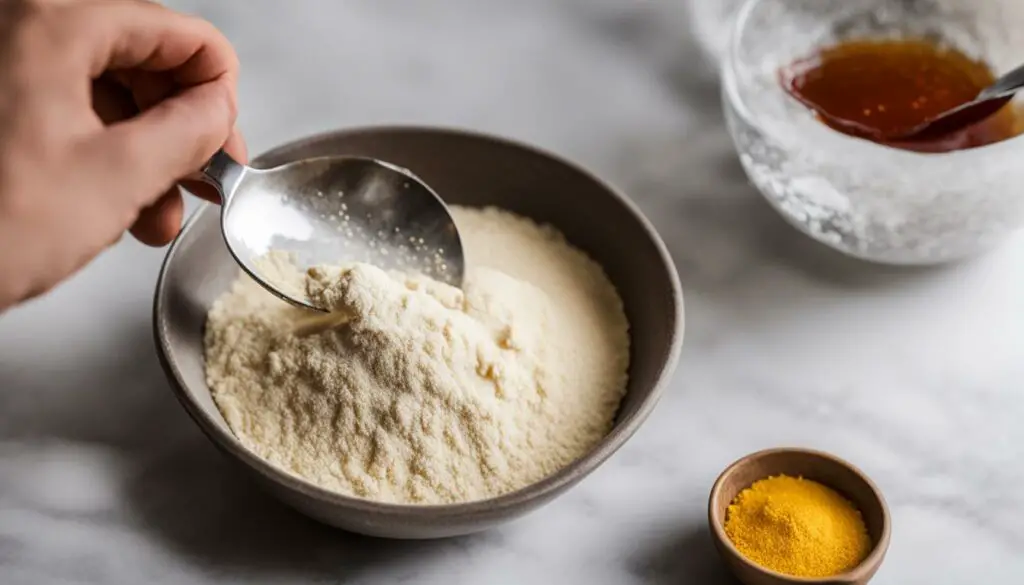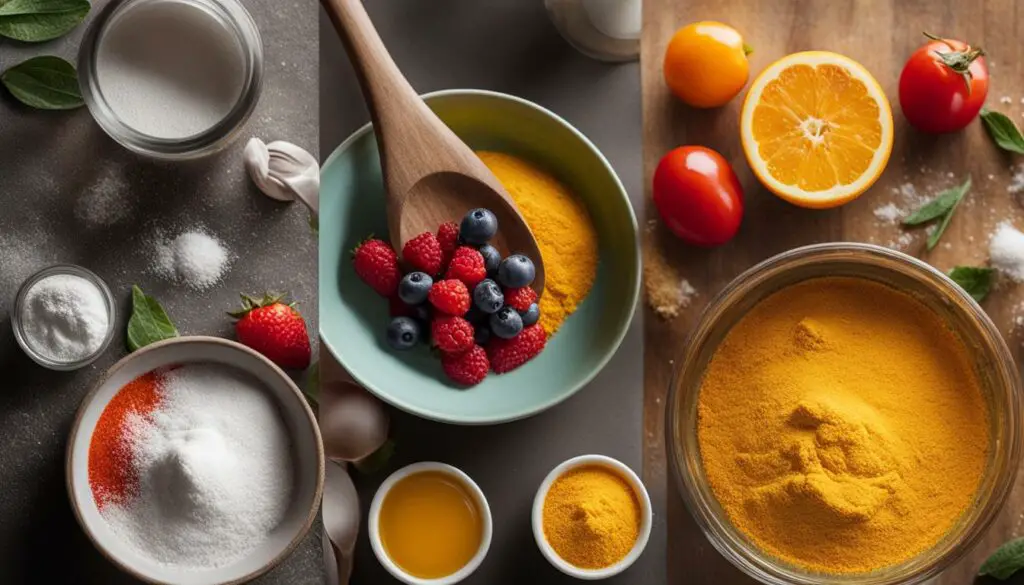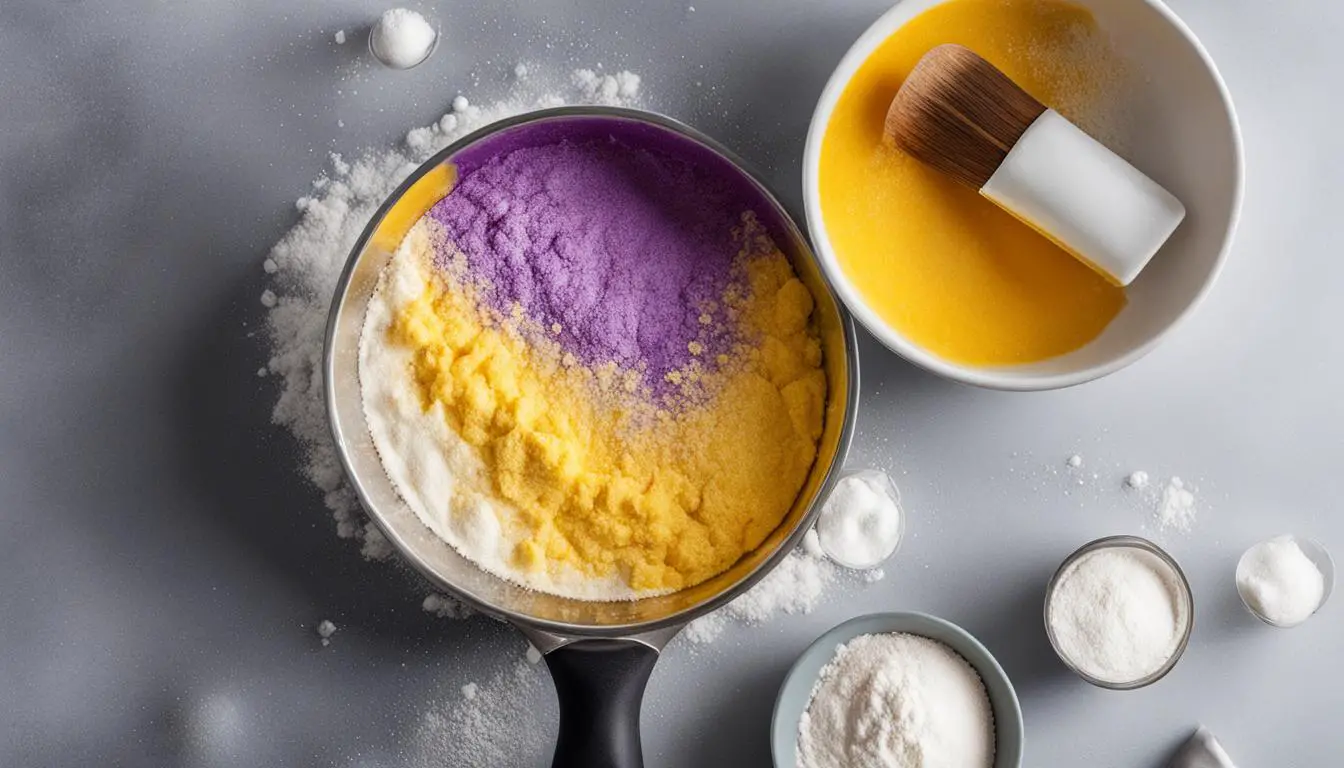Originally posted on December 13, 2023 @ 6:16 am
The use of baking powder in recipes is often essential for achieving the perfect texture and rise in baked goods. Whether you’re baking a cake, cookies, or muffins, understanding the function of baking powder can help you create light and fluffy treats that will impress your friends and family.
Baking powder is a leavening agent that helps to create a light and airy texture in baked goods. It achieves this by releasing carbon dioxide gas when exposed to moisture and heat. This gas causes the batter to expand and rise, resulting in a soft and fluffy final product.
But what exactly does baking powder do in a recipe? It acts as a rising agent, counteracting the heaviness and density of certain ingredients like flour. Without baking powder, your baked goods may turn out flat and dense. Its role is crucial in achieving that desirable airy texture that we all crave.
So the next time you’re baking, remember the importance of baking powder in recipes. It is the secret ingredient that turns ordinary batters into light and fluffy successes.
Contents
- 1 The Difference Between Baking Soda and Baking Powder
- 2 How Does Baking Powder Work in Baking?
- 3 Using Baking Powder in Recipes
- 4 Can Baking Powder and Baking Soda Be Used Interchangeably?
- 5 Testing Baking Powder and Baking Soda for Freshness
- 6 Recipes that Call for Baking Soda
- 7 Recipes that Call for Baking Powder
- 8 The Importance of Fresh Baking Powder and Baking Soda
- 9 Tips for Proper Storage of Baking Powder and Baking Soda
- 10 Troubleshooting Common Baking Powder and Baking Soda Issues
- 11 Conclusion
- 12 FAQ
- 12.1 What does baking powder do in a recipe?
- 12.2 What is the function of baking powder in recipes?
- 12.3 What is the difference between baking soda and baking powder?
- 12.4 How does baking powder work in baking?
- 12.5 Why is baking powder important in recipes?
- 12.6 Can baking powder and baking soda be used interchangeably?
- 12.7 How do you test baking powder for freshness?
- 12.8 How do you test baking soda for freshness?
- 12.9 What are some recipes that call for baking soda?
- 12.10 What are some recipes that call for baking powder?
- 12.11 Why is it important to use fresh baking powder and baking soda?
- 12.12 What are some tips for proper storage of baking powder and baking soda?
- 12.13 How can I troubleshoot common baking powder and baking soda issues?
- 12.14 What is the conclusion about baking powder in recipes?
- 13 Source Links
Key Takeaways:
- Baking powder is a leavening agent that helps create a light and fluffy texture in baked goods.
- It releases carbon dioxide gas when exposed to moisture and heat, causing the batter to rise.
- Without baking powder, baked goods may turn out flat and dense.
- Baking powder is crucial for achieving the desired airy texture in recipes.
- Remember the important role of baking powder in your next baking adventure.
The Difference Between Baking Soda and Baking Powder

When it comes to baking, understanding the difference between baking soda and baking powder is essential. Although both are leaveners, they have distinct characteristics that can affect the outcome of your baked goods.
Baking Soda: The Versatile Reactant
Baking soda, also known as sodium bicarbonate, is a pure and potent leavening agent. It is activated by an acidic ingredient, such as buttermilk, vinegar, or lemon juice. When these ingredients react with baking soda, carbon dioxide gas is released, causing the batter to rise and resulting in a light and fluffy texture.
Baking Powder: A Convenient Leavening Combination
Baking powder is a combination of baking soda and an acid, such as cream of tartar. Unlike baking soda, baking powder already contains an acid, eliminating the need for an additional acidic ingredient. This makes baking powder more versatile and convenient to use in recipes that do not have an acidic component, such as plain muffins or sugar cookies. The acid in baking powder activates the baking soda, resulting in the production of carbon dioxide gas and the desired rise in your baked goods.
The Role of Baking Powder in Cooking
Baking powder plays a crucial role in the realm of cooking. Its purpose is to leaven the batter or dough, allowing it to rise and create a soft, airy texture. Without baking powder, baked goods can turn out dense and heavy. By incorporating baking powder into your recipes, you can achieve the perfect rise and texture, ensuring delectable outcomes every time.
As seen in the image above, baking powder acts as a catalyst for a delightful rise in baking.
Now that we have explored the distinctions between baking soda and baking powder, let’s dive deeper into how baking powder works its magic in baking. Understanding the science behind this leavening agent is key to mastering the art of baking.
How Does Baking Powder Work in Baking?

When baking powder is added to a recipe, it undergoes a chemical reaction when exposed to moisture and heat in the oven. This reaction is what helps create those delicious, light and fluffy baked goods we all love.
The main purpose of baking powder is to produce carbon dioxide gas, which creates air bubbles in the batter or dough. The carbon dioxide gas is formed as a result of the reaction between the alkaline component (usually sodium bicarbonate) and the acidic component (usually cream of tartar or sodium aluminum sulfate) present in the baking powder. These components are mixed together in the right proportions to ensure optimal leavening.
As the batter or dough bakes, the carbon dioxide gas expands and gets trapped within the structure of the protein, typically eggs. This protein coagulates during baking, creating a firm network that supports and holds the air bubbles in place. This combination of air bubbles and protein structure results in a desirable light and fluffy texture in the final product.
In simple terms, baking powder provides the necessary lift and aeration to transform a dense batter or dough into a light and airy baked good. Whether it’s fluffy pancakes, tender cakes, or perfectly risen muffins, baking powder plays a key role in achieving the desired texture and volume.
By understanding how baking powder works in baking, you can make informed decisions when it comes to selecting recipes and adjusting baking powder quantities to achieve the desired effects. It’s essential to follow the specified measurements and instructions in recipes to ensure the right balance of ingredients and optimal leavening.
Using Baking Powder in Recipes
Baking powder is an essential ingredient in many recipes, delivering a range of benefits that enhance the final result. Its role in baking goes beyond the simple act of leavening, as it helps create the light and airy texture that is desired in cakes, cookies, pancakes, and other baked goods.
When added to the dry ingredients, baking powder activates during the baking process, producing carbon dioxide gas that causes the batter or dough to rise. This expansion creates air bubbles, resulting in a softer and fluffier texture in the finished product. The importance of baking powder in recipes cannot be overstated, as it is responsible for the pleasing texture that makes baked goods so enjoyable to eat.
In addition to its leavening properties, baking powder offers several other benefits. It helps to stabilize the structure of the batter or dough, preventing it from collapsing during baking. This allows the final product to maintain its shape and rise evenly. Baking powder also contributes to the flavor profile of baked goods, adding a mild, slightly tangy taste that complements sweet and savory recipes alike.
Benefits of Using Baking Powder in a Recipe
Using baking powder in recipes offers numerous advantages:
- Improved texture: Baking powder helps create a light and airy texture, resulting in tender and moist baked goods.
- Consistent rise: The controlled release of carbon dioxide gas ensures a uniform rise throughout the batter or dough.
- Enhanced flavor: Baking powder adds a subtle tang that enhances the overall taste of baked goods.
- Versatility: Baking powder can be used in recipes that do not contain acidic ingredients, making it a versatile leavening agent.
- Convenience: Baking powder is a ready-to-use ingredient, eliminating the need to combine multiple components for leavening.
To fully appreciate the importance of baking powder in recipes, it is crucial to incorporate it correctly. Follow the recipe’s instructions for the appropriate amount of baking powder, as using too much or too little can affect the texture and rise of the baked goods. Additionally, store baking powder in a cool and dry place to maintain its effectiveness over time.
By utilizing baking powder in your recipes, you can achieve professional-quality results that will impress and delight your friends and family. Whether you’re baking a fluffy cake, tender cookies, or golden pancakes, baking powder is an indispensable ingredient that ensures baking success.
Can Baking Powder and Baking Soda Be Used Interchangeably?
Baking powder and baking soda may seem similar, but it’s important to understand that they are not interchangeable ingredients in recipes. Let’s take a closer look at the differences between these leavening agents and why substituting one for the other can lead to undesirable baking outcomes.
Baking Soda:
Baking soda, also known as sodium bicarbonate, is a base that requires an acidic ingredient to activate its leavening properties. When mixed with an acid, such as buttermilk, lemon juice, or vinegar, baking soda produces carbon dioxide gas, which helps dough or batter rise.
Baking Powder:
Baking powder, on the other hand, is a mixture of baking soda, an acid (like cream of tartar), and a drying agent (such as cornstarch). This pre-mixed combination allows baking powder to react with moisture and heat, releasing carbon dioxide gas and causing batter or dough to rise.
So, while baking soda requires an acidic ingredient to activate, baking powder already contains an acid. This difference in composition means that substituting one for the other can result in a less than satisfactory outcome in your baked goods.
What Happens When You Substitute?
If you were to substitute baking powder for baking soda, your baked goods may lack the necessary acid to activate the leavening process. This can result in a flat or dense texture, rather than the light and fluffy texture you desire.
Follow the Recipe’s Instructions:
To ensure the best results in your baking, it’s essential to follow the recipe’s instructions and use the specified leavening agent. If a recipe calls for baking soda, use baking soda. If it calls for baking powder, use baking powder. This way, you’ll achieve the desired texture and rise in your finished products.
Now that we understand that baking powder and baking soda cannot be used interchangeably, let’s move on to the next section to explore how to test these leavening agents for freshness.
Testing Baking Powder and Baking Soda for Freshness

Both baking powder and baking soda can lose their effectiveness over time. To ensure optimal leavening in your baked goods, it is important to test them for freshness before using them in a recipe.
To test baking powder:
- Add a teaspoon of baking powder to a glass of hot water.
- If the baking powder bubbles up vigorously, it is still active and can be used in your recipes.
To test baking soda:
- Add a teaspoon of baking soda to some vinegar.
- If the baking soda foams and bubbles, it is still good and can be used in your recipes.
If either the baking powder or baking soda fails these tests, it is time to replace them with fresh ones to ensure proper leavening in your baked goods.
Testing the freshness of baking powder and baking soda is a quick and easy way to ensure successful baking results. By using fresh ingredients, you can enjoy light and fluffy baked goods every time.
Recipes that Call for Baking Soda

When it comes to adding a tangy flavor, promoting browning, and contributing to the texture of baked goods, baking soda plays a vital role in various recipes. This leavening agent is commonly used in dishes that require an acidic ingredient to activate and produce carbon dioxide gas. Here are some examples of recipes that call for baking soda:
- Irish soda bread
- Oatmeal raisin cookies
- Recipes using buttermilk
- Cocoa powder-based recipes
Baking soda not only helps in leavening the dough or batter but also adds a distinct tanginess and aids in browning the final product. Its unique properties make it a key ingredient in various baked goods, from quick breads to cookies and cakes.
Adding baking soda to your favorite recipes can elevate the taste and texture of the finished product. Whether you’re looking for a tangy twist, enhanced browning, or a special texture, experimenting with baking soda can lead to delightful culinary creations.
Recipes that Call for Baking Powder

Baking powder is a versatile leavening agent that is used in various recipes to create a light and fluffy texture without the need for additional acidic ingredients. Here are some delicious recipes that call for baking powder:
Pancakes
Start your day off right with fluffy pancakes made with baking powder. Whether you prefer classic buttermilk pancakes or want to experiment with flavors like blueberry or chocolate chip, baking powder helps these breakfast favorites rise to perfection.
Strawberry Shortcake
Indulge in the sweetness of summer with a delightful strawberry shortcake. Baking powder is essential in the biscuit-like shortcake base, creating a light and tender texture that perfectly complements the juicy strawberries and whipped cream.
Vanilla Cake
A classic vanilla cake is a crowd-pleasing dessert for any occasion. Baking powder is the key ingredient that gives this cake its airy crumb and ensures a light and moist texture. Decorate with your favorite frosting or add a layer of fruity filling for extra deliciousness.
No matter the recipe, using baking powder enhances the texture and overall quality of your baked goods. Its ability to leaven the batter without relying on acidic ingredients opens up a world of culinary possibilities.
| Recipe | Description |
|---|---|
| Pancakes | A breakfast staple, these fluffy pancakes are light and tender thanks to the addition of baking powder. |
| Strawberry Shortcake | A delightful summer dessert featuring layers of sweet strawberries, whipped cream, and a light, biscuit-like shortcake made with baking powder. |
| Vanilla Cake | A classic cake with a moist and airy texture, thanks to baking powder. Perfect for birthdays, celebrations, or simply indulging in a sweet treat. |
The Importance of Fresh Baking Powder and Baking Soda

Using fresh baking powder and baking soda is crucial for achieving the desired results in your baking. As leavening agents, both baking powder and baking soda play a key role in creating light, fluffy, and perfectly risen baked goods.
So why is it important to use fresh baking powder and baking soda?
Old or expired baking powder or baking soda may not produce enough carbon dioxide gas, resulting in flat or dense baked goods. The freshness of these ingredients directly affects the leavening process, which is essential for achieving the desired texture and structure in your recipes.
When baking powder and baking soda are fresh, they are potent and effective in generating the necessary gas to make your baked goods rise. However, over time, their effectiveness diminishes, leading to disappointing results.
- Baking Powder: Over time, baking powder can lose its potency due to exposure to moisture and air. This can hinder its ability to produce the necessary carbon dioxide gas, resulting in dense and heavy cakes, cookies, and other baked treats.
- Baking Soda: Similarly, baking soda can lose its potency when exposed to air and moisture. When it loses its effectiveness, it may not produce enough carbon dioxide gas to give your baked goods the desired rise and lightness.
Regularly checking the freshness of your baking powder and baking soda before using them in your recipes is essential. By doing so, you can ensure that your baked goods turn out light, airy, and perfectly baked every time.
Here are some tips to ensure you are using fresh baking powder and baking soda:
| Baking Powder | Baking Soda |
|---|---|
| Check the expiration date on the container. Replace it if it has expired. | Mark the purchase date on the box. Replace it every six months to a year. |
| Add a teaspoon of baking powder to a glass of hot water. If it bubbles up vigorously, it is still active. | Add a teaspoon of baking soda to some vinegar. If it foams and bubbles, it is still good. |
| Store baking powder in a tightly sealed container at room temperature. | Store baking soda in a cool and dry place, such as your pantry. |
By following these guidelines and ensuring the freshness of your baking powder and baking soda, you can elevate your baking to new heights and consistently achieve delicious and perfectly leavened baked goods.
Tips for Proper Storage of Baking Powder and Baking Soda
Properly storing your baking powder and baking soda is essential to maintain their freshness and ensure their effectiveness in your baking endeavors. Follow these tips to keep them at their best:
1. Choose a Cool and Dry Storage Location
Select a cool and dry place to store your baking powder and baking soda. Exposure to moisture and humidity can compromise their quality and potency, leading to subpar results in your baked goods. Avoid storing them near the stove, sink, or any other areas prone to moisture.
2. Keep Baking Powder’s Container Sealed
Baking powder typically comes in a tightly sealed container to protect it from moisture and air. Always make sure to seal the container tightly after each use to prevent moisture from entering and affecting its performance.
3. Check the Expiration Date
Regularly check the expiration date on your baking powder container. As time goes by, baking powder can lose its effectiveness and fail to leaven your batter properly. Replace it with a fresh container as needed to ensure optimal results in your baked goods.
4. Store Baking Soda in a Dry Place
Baking soda, on the other hand, is typically packaged in a box. Similar to baking powder, store it in a cool and dry place away from moisture. It’s best to keep it sealed in its original packaging to protect it from humidity.
5. Mark the Purchase Date for Baking Soda
To keep track of the freshness of your baking soda, mark the purchase date on the box. Baking soda can lose its potency over time, so it’s recommended to replace it every six months to a year, even if the expiration date hasn’t been reached yet.
By taking proper care of your baking powder and baking soda, you can ensure that they remain effective and produce excellent results in your baking endeavors.
Troubleshooting Common Baking Powder and Baking Soda Issues
If you encounter issues with your baking powder or baking soda, such as flat or dense baked goods, it is important to troubleshoot the problem. Here are some troubleshooting tips to help you resolve common issues:
Troubleshooting Baking Powder Issues
1. Check the freshness: Baking powder can lose its effectiveness over time. Test it by adding a teaspoon to a glass of hot water. If it bubbles up vigorously, it is still active.
2. Measure accurately: Using too much or too little baking powder can impact the rise and texture of your baked goods. Follow the recipe’s instructions for the correct amount.
3. Proper mixing: Be sure to thoroughly mix the baking powder into the dry ingredients to ensure even distribution and activation during baking.
4. Baking techniques: Pay attention to the recommended oven temperature and baking time in the recipe. Baking at too high a temperature or opening the oven door too frequently can affect the performance of the baking powder.
Troubleshooting Baking Soda Issues
1. Check the freshness: Baking soda can also lose its potency over time. Test it by adding a teaspoon to some vinegar. If it foams and bubbles, it is still good.
2. Acidic ingredients: Baking soda requires an acidic ingredient to activate and create the necessary leavening. Ensure that your recipe includes an acidic component like buttermilk, yogurt, or vinegar.
3. Balanced recipe: Baking soda needs to be used in the correct proportion to the other ingredients in the recipe. Double-check your measurements to ensure accuracy.
4. Mixing technique: Properly combining the baking soda with the other ingredients is crucial for an even rise and texture. Be thorough when mixing everything together.
If you’ve gone through these troubleshooting steps and are still experiencing issues, don’t hesitate to reach out to a baking expert or consult reliable recipe sources for guidance on specific baking powder and baking soda issues related to your recipes.
Using these troubleshooting tips, you can overcome common problems with baking powder and baking soda and ensure successful and delightful baked goods every time.
Conclusion
In conclusion, baking powder is an essential ingredient in recipes that require a light and fluffy texture. By leavening the batter, it helps to create air pockets that result in a soft and airy final product. Understanding the differences between baking powder and baking soda is crucial, as they have distinct properties and functions. Baking powder’s versatility allows it to be used in a wider range of recipes, even those that do not have an acidic ingredient.
When using baking powder, it is important to maintain freshness and accuracy in measurements. Testing for freshness and storing it properly will ensure optimal leavening power. Following recommended guidelines and techniques will elevate your baking, allowing you to unlock the full potential of baking powder in your recipes.
So, whether you’re making pancakes, cakes, or cookies, remember the importance of baking powder in achieving that light and fluffy texture. With the right knowledge and techniques, you can confidently incorporate baking powder into your recipes and impress your family and friends with delicious baked goods.
FAQ
What does baking powder do in a recipe?
Baking powder is a leavening agent that helps create a light and fluffy texture in baked goods.
What is the function of baking powder in recipes?
Baking powder leavens the batter by producing carbon dioxide gas, causing it to rise and create a soft and fluffy texture.
What is the difference between baking soda and baking powder?
Baking soda requires an acidic ingredient to activate it, while baking powder already contains an acid and can be used in recipes without an acidic ingredient.
How does baking powder work in baking?
Baking powder reacts with moisture and heat in the oven, producing carbon dioxide gas that creates air bubbles and helps the batter rise.
Why is baking powder important in recipes?
Baking powder is essential for achieving a light and airy texture in baked goods.
Can baking powder and baking soda be used interchangeably?
No, they are not interchangeable as they have different properties and functions in recipes.
How do you test baking powder for freshness?
Add a teaspoon of baking powder to a glass of hot water. If it bubbles up vigorously, it is still active.
How do you test baking soda for freshness?
Add a teaspoon of baking soda to some vinegar. If it foams and bubbles, it is still good.
What are some recipes that call for baking soda?
Recipes that call for baking soda include Irish soda bread, oatmeal raisin cookies, and recipes that use buttermilk or cocoa powder.
What are some recipes that call for baking powder?
Recipes that call for baking powder include pancakes, strawberry shortcake, and vanilla cake.
Why is it important to use fresh baking powder and baking soda?
Fresh leavening agents ensure optimal leavening and a light texture in baked goods.
What are some tips for proper storage of baking powder and baking soda?
Store baking powder at room temperature in its tightly sealed container, and store baking soda in a cool and dry place.
How can I troubleshoot common baking powder and baking soda issues?
Check the freshness of your leavening agents, use the correct amount specified in the recipe, and follow proper mixing and baking techniques.
What is the conclusion about baking powder in recipes?
Baking powder is a crucial ingredient for achieving a light and fluffy texture in baked goods, and it should be used according to the recipe’s instructions for optimal results.








